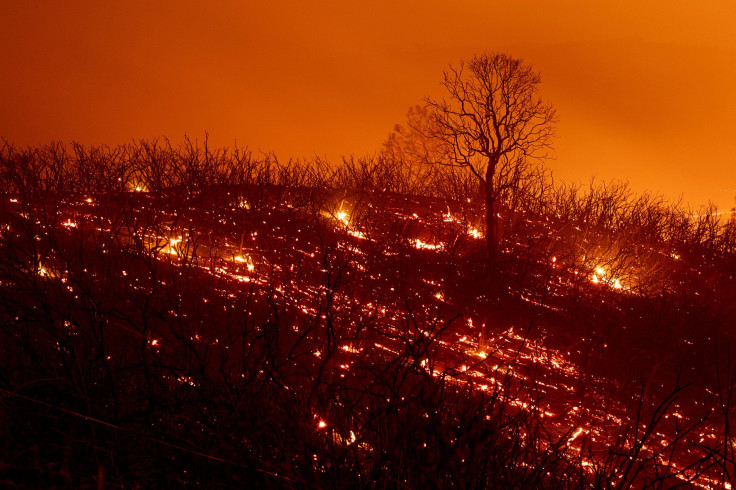Holy Fire, California: 4000-Acre Blaze In Orange County Prompts Evacuations, Firefighters Hospitalized

Holy fire, the blaze that started in the Holy Jim area of Orange County, California, on Friday, quickly grew to 4,000 acres, prompting mandatory evacuations in the region.
The fire started at around 1:17 p.m. local time (4:17 p.m. EDT) and quickly spread toward the Main Divide forest road, near Riverside County communities including south Corona, El Cerrito and Glen Ivy Hot Springs by 8:20 p.m. local time (11:20 p.m. EDT), according to the Forest Service. The fire, as of Monday, was zero percent contained.
“Given the weather conditions and the fuel moistures that I’ve been hearing about, you know and the drought conditions, it doesn’t surprise me that it is burning this fast in chaparral," Jeanna Smith of the United States Forest Service said, CW affiliated KTLA reported. "And that area hasn’t burned for quite a while, so we’re looking from 6 to 10 feet in some areas.”
Around 600 firefighters remained at the scene, fighting the blaze as of Monday. Two of them suffered heat exhaustion and were rushed to a nearby hospital for treatment.
A number of photos and videos of the fire was shared on social media:
Huge retardant drop by the impressive 747 Global Supertanker trying to keep the flames of the #HolyFire from coming over the ridge. Just captured this here in Corona. @NBCLA pic.twitter.com/uzrlRdqz2S
— Kenny Holmes (@KHOLMESlive) August 7, 2018
The @hpwren station on Santiago Peak has a front row seat to the #HolyFire in the Cleveland National Forest. Here's a screen grab from one of their webcams from a few minutes ago: pic.twitter.com/ezzgQwKOtR
— Lita Martínez 🇨🇺 (@litajmartinez) August 6, 2018
That giant smoky cloud behind Angel Stadium is from the Holy Fire, which is burning less than 30 miles from here. pic.twitter.com/YKlKTLMBIt
— J.P. Hoornstra (@jphoornstra) August 7, 2018
WATCH: The #HolyFire scorches hundreds of acres in Orange County's Trabuco Canyon, as captured by @Stu_Mundel in Sky2. Get the latest here: https://t.co/c787XtBLWo pic.twitter.com/nnkhH1LC8r
— CBS Los Angeles (@CBSLA) August 6, 2018
The popular hiking trail that goes from the Trabuco Creek area to Santiago Peak was surrounded by the fire. Two hikers became stranded in the area and had to air-lifted to safety.
According to fire officials, at least one home was destroyed by the Holy Fire, although they have refrained from mentioning how many houses remain under threat. An aerial video from Sky5 showed three structures had been burnt.
The Orange County Fire Authority (OCFA) said by Monday evening, the Holy Fire was moving away from the Orange County and toward the Temescal Valley.
Evacuation orders of Holy Jim Cabins, Blue Jay Campground, and Falcon Campground will remain in place. The care and reception center at Bell Tower Community Center will remain open until midnight tonight. #HolyFire @OrangeCountyEOC
— OCFA PIO (@OCFireAuthority) August 7, 2018
An evacuation center was set up at the Bell Tower Community Center at 22232 El Paseo in Rancho Santa Margarita. People looking for more information regarding the evacuations or shelter can contact 714-628-7085.
Holy Fire is one of the 16 fires the state of California is grappling with at present. However, the most extensive of these fires is the Mendocino Fire, the name given to the combination of two major blazes – the Ranch Fire and the River Fire.
Growing at the rate of 80 percent since Friday, it has engulfed 283,800 acres in multiple counties including Lake, Colusa and Mendocino – which is more than last year's Thomas Fire, which burned 281,893 acres in Ventura and Santa Barbara counties, making this the largest wildfire California has ever encountered.
The fire has destroyed 75 homes so far and was contained 30 percent as of Monday.
The Carr Fire, which spread to 164,413 acres and was 47 percent contained as of late Monday evening, has already claimed the lives of seven people, the latest victim being utility worker Jairus Ayeta who died a vehicular accident while trying to restore power in a rough terrain.
Meanwhile, officials announced Sunday that parts of Yosemite National Park will remain indefinitely closed as the Ferguson Fire that started July 13 continues to threaten the safety of the visitors and workers at the park. The fire reached 91,502 acres as it entered the third week and was contained about 38 percent.
"Over the past 48 hours, fire has impacted all of the roads used to access Yosemite Valley, burning dead and downed trees that can become very explosive and fall without warning," National Park Service said.
President Donald Trump weighed in on the growing California wildfire, blaming the state’s environmental laws for the blaze not being put out yet. He tweeted:
However, none of the over 14,000 firefighters who have been battling the wildfires across California, have complained about the lack of water supply in the region. Henri Grissino-Mayer, a geography professor at the University of Tennessee told CNN he was confused by Trump’s statement.
“California does NOT divert water to the ocean," he said. "Ridiculous. It's true that water is diverted to the coastal cities for a constant water supply but all such water is used by the coastal communities."
© Copyright IBTimes 2024. All rights reserved.





















